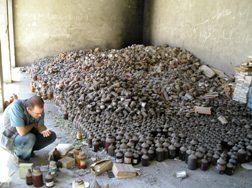
Geoscientist 17.8 August 2007
Michael Watts and Clive Mitchell report on the continuing work of the British Geological Survey in Afghanistan.
The British Geological Survey (BGS) has been working in Afghanistan for almost three years, funded by the Department for International Development (DfID) to provide ‘institutional strengthening’ to the Afghanistan Geological Survey (AGS) (Geoscientist 2005, 15.9; 2003, 13.3). During the course of this project, the AGS buildings in Kabul have been refurbished thanks to USAID, thus enabling donor organisations (e.g. DfID-BGS) to begin implementing technology and skills transfer programmes. One of the objectives of the BGS project was to install a basic laboratories capability and a team of BGS staff currently provides a comprehensive back-to-work training programme for laboratory staff.
The first training goal was to improve the computer literacy and English language of AGS staff. We then designed and implemented a phased set-up for a suite of laboratories to deal with sample preparation, industrial minerals, thin section, petrography/ palaeontology, gem analysis and chemistry.
Sample preparation is the heart of any suite of laboratories and often contains the most straightforward equipment for training. We found it was a good place to re-establish basic principles, such as record keeping, sample tracking, and anti-contamination and H&S procedures. Our first group of 12 trainees was split into two teams that undertook a survey of construction materials in the Greater Kabul area. They were trained in sample collection, logging locality information, labelling samples prior to preparation and subsequent physical properties tests in the new Industrial Minerals laboratory.
AGS teams took responsibility for this survey in the periods between BGS staff visits, and their findings will form part of a database of construction materials outlets and sources in Greater Kabul. This experience was valuable in preparing the installation of other laboratories. AGS staff became more motivated, and their technical, IT and language skills improved with practice. It also became apparent that the transfer of responsibility for equipment maintenance and use had to be fairly rapid to ensure that work continued between BGS training visits.
As other laboratories became operational the BGS team became involved in the set-up and training of the AGS staff who would eventually run and maintain them. Thin Section staff were initially employed in restoring and logging thin section and microfossil slides, many of which dated from the 1960s and had been salvaged from the wreckage of the building. This enabled the trainees to practise their IT skills until the thin section equipment arrived. The Afghans were eager to start practical work, and with minimal guidance were soon producing thin sections to a reasonable quality for petrographic analysis. They quickly took to the modern equipment and demonstrated good technical ability based on experience gained when the AGS was under Soviet control. They were trained to produce thin sections from a variety of local rock materials, under the watchful eye of local and BGS petrographic experts. The very first thin section to be made in the AGS for about 20 years (a Proterozoic garnet mica schist from central Kabul) was proudly completed in March this year.
Gradually, systems of work are being introduced as the new laboratories come on-stream. These include a sample registration database; technical test work and data evaluation; health and safety advice and risk assessment, and individual staff training records, to ensure the continuing safe use of equipment.
Ultimately, the future of the AGS laboratories depends on collaboration between local staff and donor organisations to sustain the substantial progress made so far. AGS is eager to regain its laboratory capabilities so that it can once again participate actively in promoting Afghanistan’s considerable mineral resources to local and international mining companies. Their hope is that developing the country’s mineral potential will, through boosting the economy, employment and revenues, help to create a more stable future for Afghanistan.